From Jiayuguan to Charley Johng's Dune Guesthouse
Standing-room tickets—which let you get on the train but don't assure you of a seat—are never fun, and are probably least fun when on a train leaving at three in the morning.
I was lucky enough to find a seat, but the car was full of people trying desperately to sleep on uncomfortable hard seats arranged facing each other, with garbage and spilled drinks littering the tables and floor. I managed to get a couple hours sleep, and when I awoke was able to enjoy the rising sun over the desert.
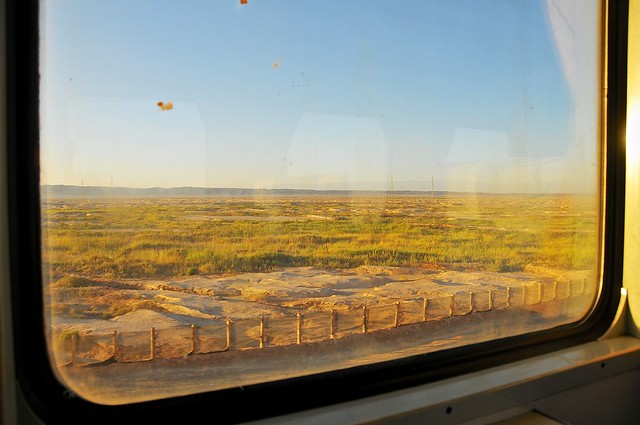 |
| Early morning on the night train. |
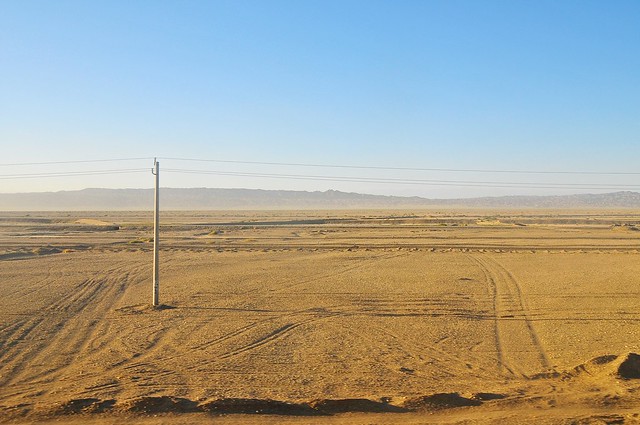 |
| This is still part of the Gobi, just like it was way back in Shainsand, Mongolia. |
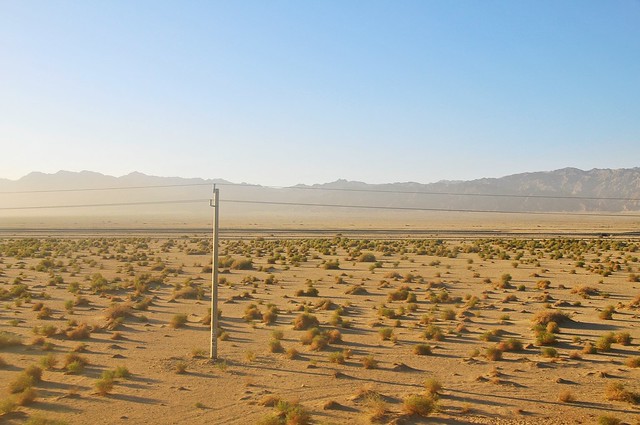 |
| It makes you wonder what else you miss by traveling at night. |
The train station in Dunhuang is some way east of the town, and when the train arrives there is a big rush and excited taxi drivers and touts. You can ignore them, as you can take a bus into town for about 5 yuan. Any of the green minibuses in front of the station will be going into town.
I decided to stay at one of the hostels by the sand dunes, and at the time Charley Johng's was the only one of the dune hostels listed in Lonely Planet. I went to the cafe of the same name in town to ask about both this dune guesthouse and his hostel in town, but the lady there said only the dune hostel had room. It turned out that this was basically a lie, and that in reality the hostel in town had been sold and was under different ownership, so all guests were directed to the dune hostel. You can take a green minibus to the dunes for about 3 yuan.
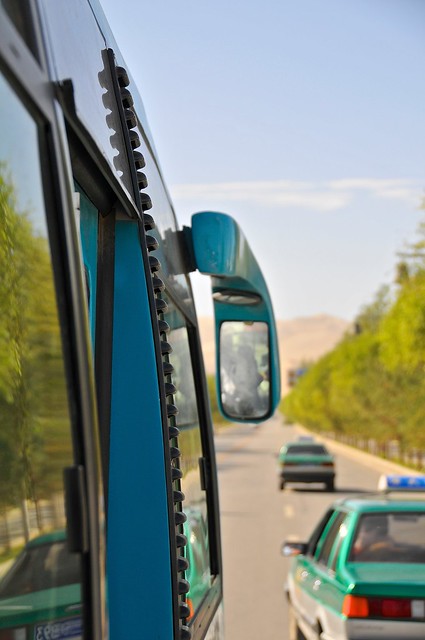 |
| On the bus to the sand dunes. |
 |
| You take a few turns off the main road to get to Charley Johng's, but there are signs along the way. |
 |
| Birds on a wire. |
 |
| There's a volleyball court right next to the guesthouse. |
The main thing going for Charley Johng's is the location. Other than that, it's not the greatest. The toilets are smelly and fly-infested, and the toilet-paper baskets are usually full and smelly. There are flies in the common areas, and not much hot water for showering. I was pretty unimpressed, but the location makes it convenient for seeing the dunes (especially if you're going to sneak into the park to see the sunrise)—if inconvenient for seeing the town.
Singing Dunes & Crescent Lake
The so-called singing dunes are one of the two major attractions of Dunhuang (the Mogao caves being the other), and the Chinese are well aware of their tourist appeal. Tickets to enter the dune area are 120 yuan each, but you can avoid the fees by walking west until you find a gap in the fence. Depending on when you do this, you will find guards that prevent you from getting close to Crescent Lake, the picturesque little lake nestled between high dunes, but if you go either early enough or late enough you probably won't be bothered by them.
The first time I visited was after taking a long nap, so I didn't arrive at the central dune area until around 6:00, and although I didn't get that close to the lake, I wasn't bothered by security guards.
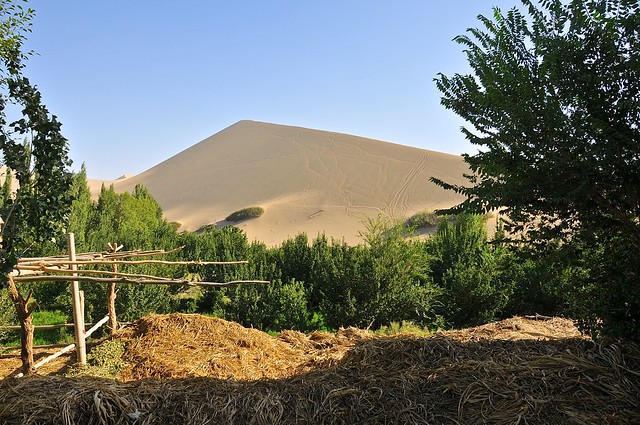 |
| Farmer's field on the edge of the dunes. |
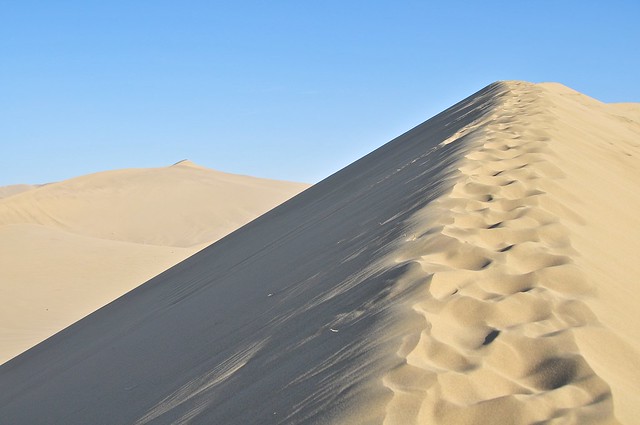 |
| Climbing a ridge well west of the main tourist section. |
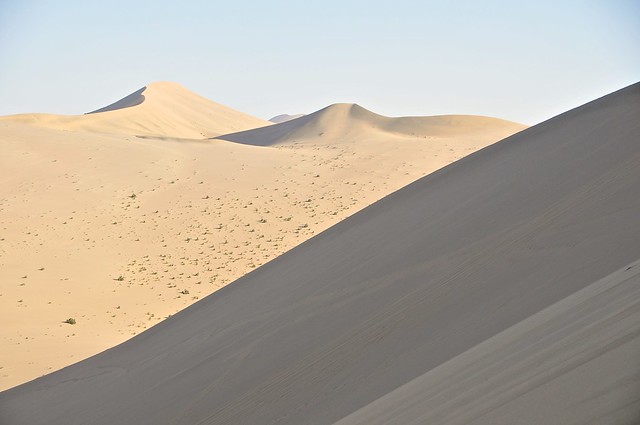 |
| Vegetation gains a foothold in the dunes. |
 |
| Crescent lake from the west. Those mountains in the background are next to the ravine where the Mogao caves are, and the train station would be to the left of them. |
The crescent lake is very picturesque, but at the same time you should realize that any time you see a perfect photograph of it that makes it look like a timeless jewel isolated in the middle of endless dunes you are seeing a very selective representation. The lake has never been more than a couple of hundred meters from verdant fields and pastures, and it has long had an access road connecting it to the nearby tourist complex.
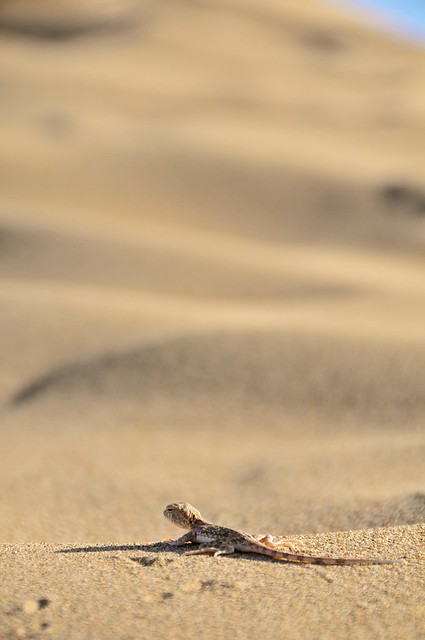 |
| Little sand lizard. |
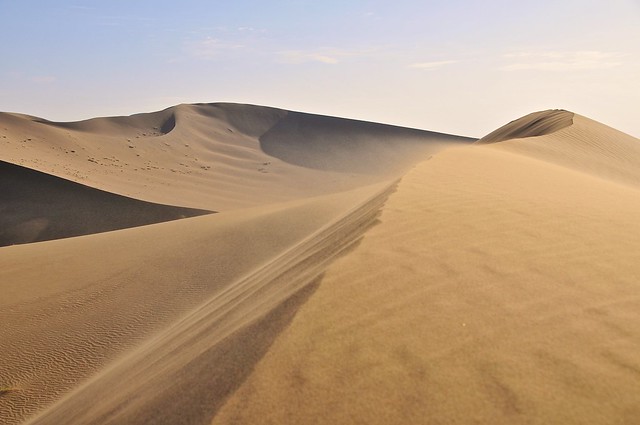 |
| The wind blows sand over the ridge. |
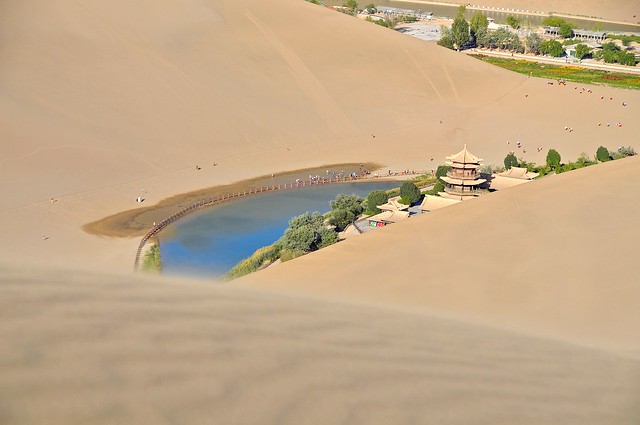 |
| The blurriness on the foreground dune is blowing sand. |
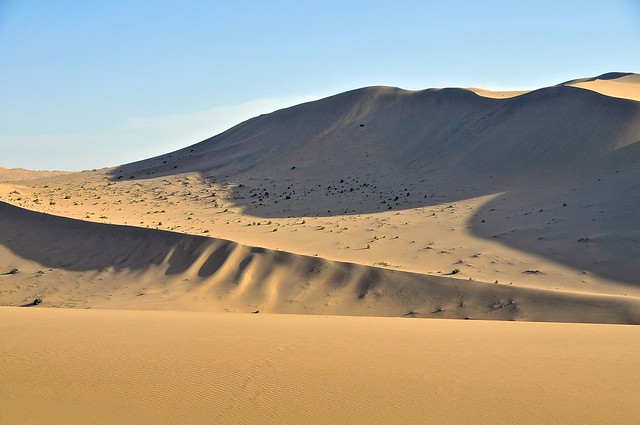 |
| Looking north to un-touristed dunes. |
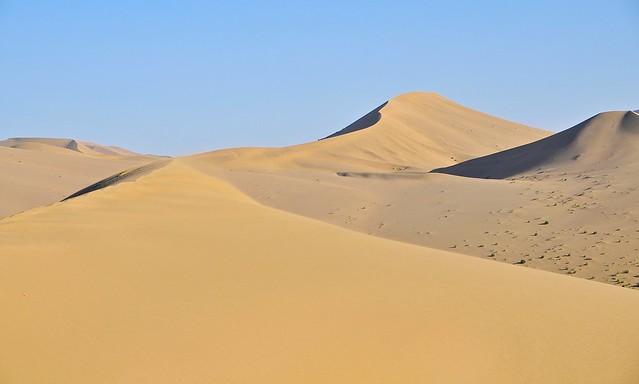 |
| Less than a kilometer away from the hordes of tourists you could find yourself in unspoilt and un-tracked dunes. |
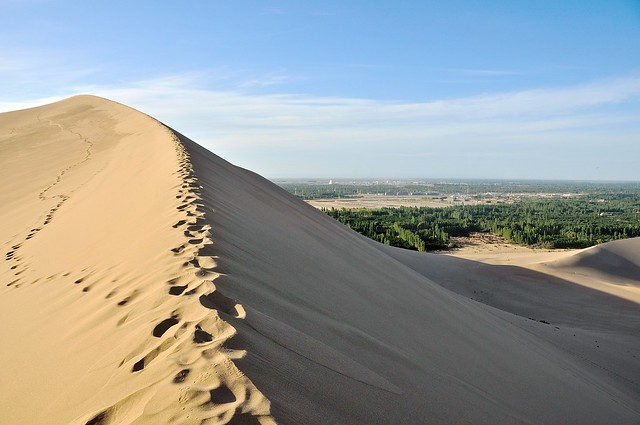 |
| Looking north, and back towards town. |
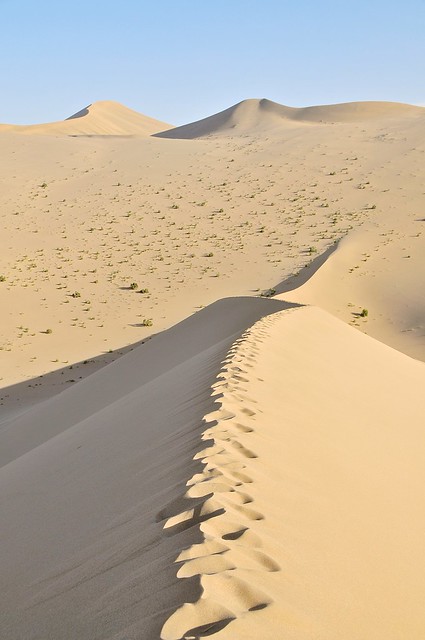 |
| And south, away from town. |
 |
| In retrospect, it would have been interesting to have walked further into the dunes. If only it wasn't so difficult to climb the darn things. |
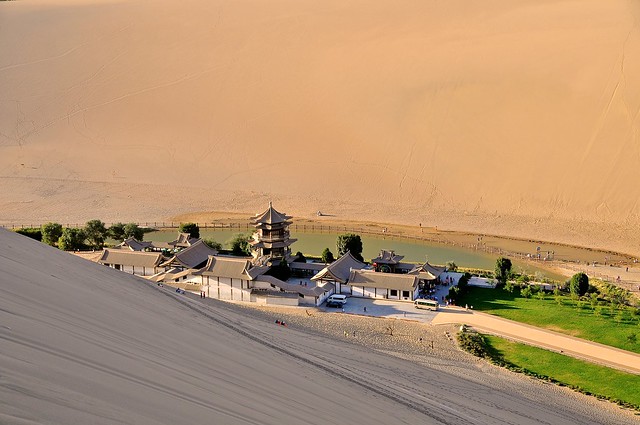 |
| Looking south over Crescent Lake. |
 |
| Ridge, up close. |
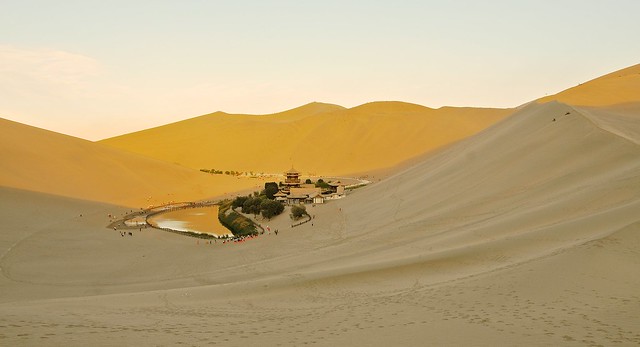 |
| The sun sets on Crescent Lake, as seen from the heavily-touristed area. |
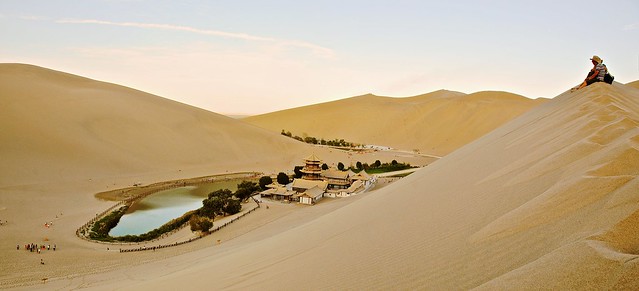 |
| Chinese tourists soaking up the atmosphere. You can tell they're not your average Chinese tourists because they're in bare feet, as opposed to the bright orange shoe protectors that almost all Chinese tourists rent. |
 |
| Serpentine ridge on eastern section of dunes. |
 |
| At
9:30, shortly after sunset, the camels that give rides to tourists at the dunes are returned to
their stables. They pass by Charley Johng's in total darkness, with only
the soft thumping of their feet as they trot past alerting you to their
presence. |
Day 2: White Horse Pagoda and city
I was feeling a little under the weather and spent a lot of the day sleeping and just taking in the city at a relaxing pace, wandering and walking. I still had my cough from Beijing, so I visited a pharmacy to get some pills they suggested, and ate lots of yoghurt. It didn't really help.
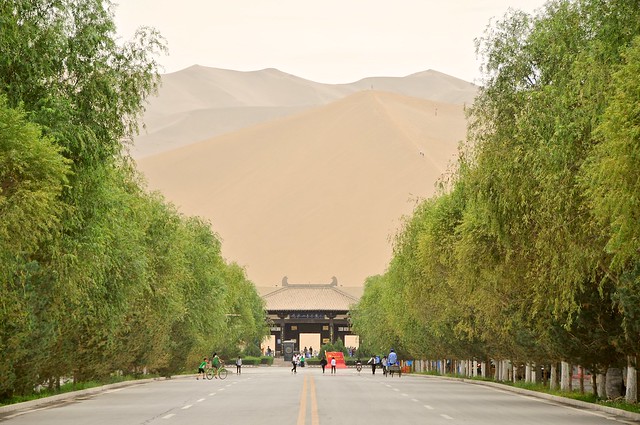 |
| The road to the ticket gate with the dunes behind. |
I made a trip to the
White Horse Pagoda, which is west of the river and a bit south of the main road in the western section of town. The pagoda was pretty unimpressive, but the area of town it was in was fascinating: traditional local-style buildings, made of mud brick, in contrast to the modern monstrosities that characterize so much of China today.
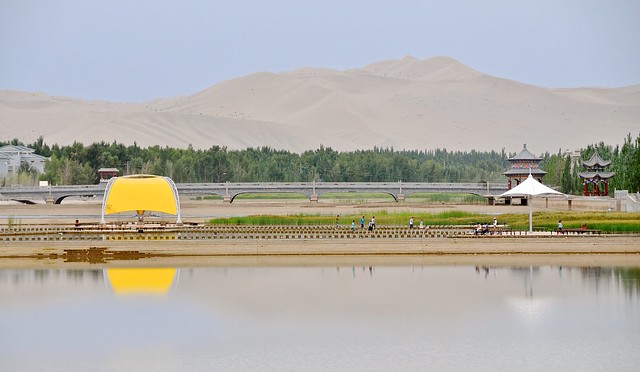 |
| The Danghe river is being developed into a park. that essentially floats on the still, dammed river. |
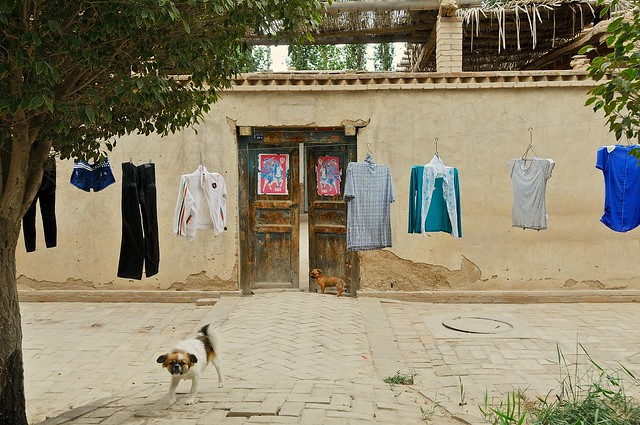 |
| Traditional village houses near the White Horse Pagoda. |
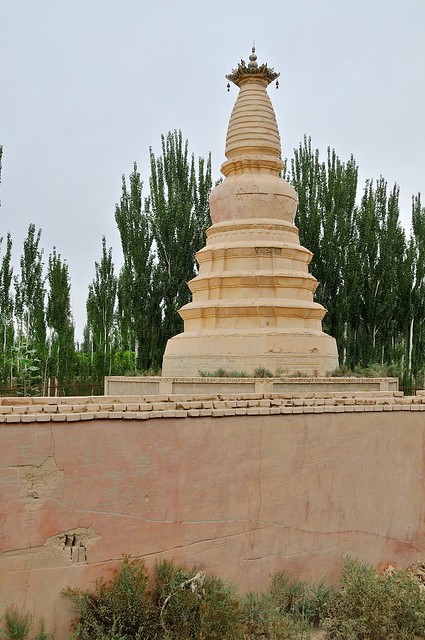 |
| The White Horse Pagoda, dedicated to a valiant steed who brought a traveler safely across the desert to Dunhuang before expiring. |
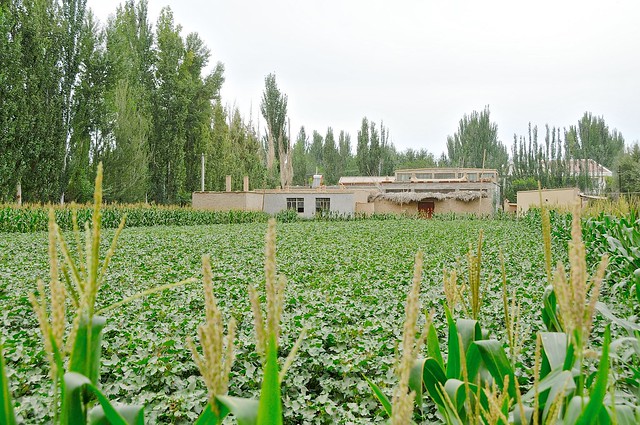 |
| Modern-traditional farmhouse. |
 |
| Corn fields surround the pagoda. |
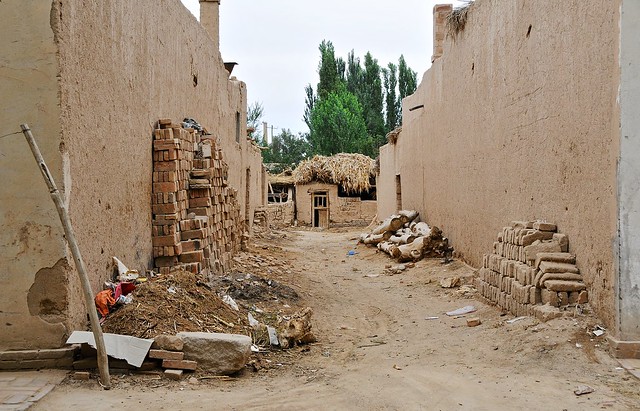 |
| Mud-brick houses unlike anything I've seen so far in China. The garbage disposal system, on the other hand, is very Chinese. |
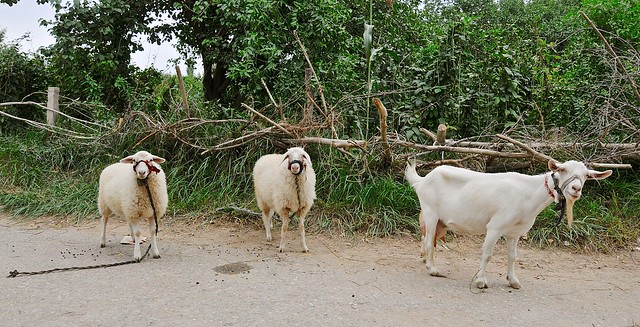 |
| Livestock just chilling in the street. |
 |
| The old houses are being razed so that wide streets and modern apartments near the river can be built. |
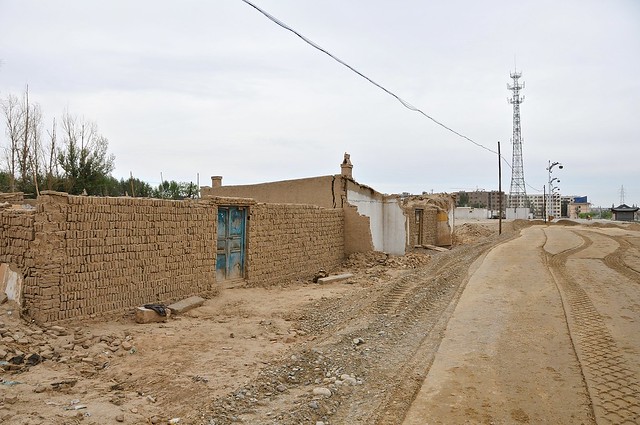 |
| You can see the use of vertically-lain mud bricks in the construction of the house with the blue door. Progress marches on, without pity. |
Day 3: sunrise over the dunes
Dunhuang is 1,800 km west of Beijing, but like all of China it is part of the same time zone and officially runs on Beijing time. The benefit of this is that the sun rises and sets later in the west—with
sunrise around 6:30 and sunset around 8:30 in mid-August. This made it a little easier to make the trip to see sunrise on the dunes a little easier than it might have been had China been using sensible time zones.
Equipped with a flashlight, I left the hostel around 5:00 and made if to the top of the dune behind Crescent Lake by about 5:30, plenty of time before sunrise. The fence around tha lake is illuminated, as are the temple buildings, but these lights were way too bright to allow photographs that reasonably exposed both the lights and the scenery. And since there was so much cloud cover, the situation only improved around sunset to the lights being balanced by drab grey skies and featureless dunes.
 |
| Crescent Lake about half an hour before dawn, at 6:05. Tourists aren't supposed to climb this dune, though this rule is enforced selectively at best. |
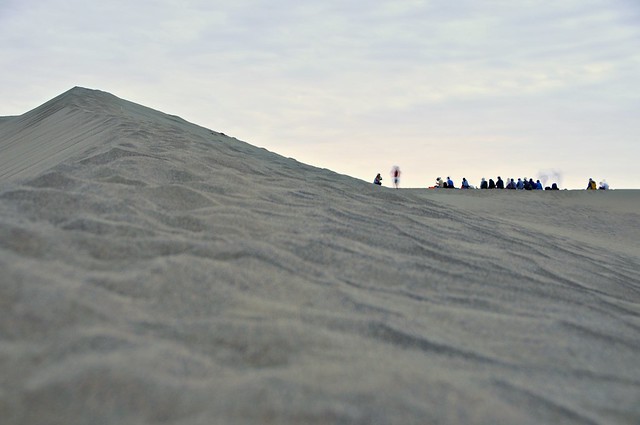 |
| Some early-bird Chinese tourists wait for sunrise at the crest of a dune. |
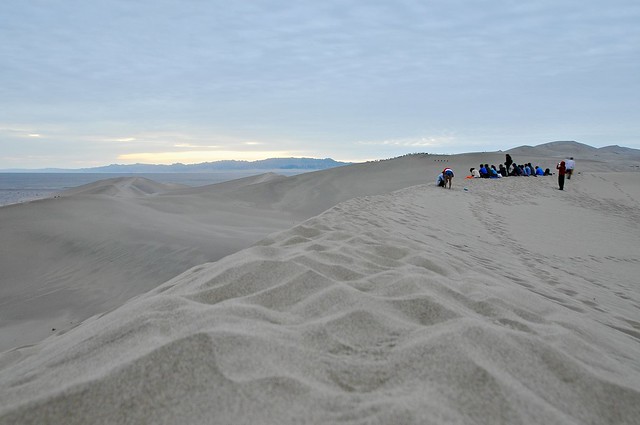 |
| It's popular to see sunrise from mountains in Asia; here they're looking towards the mountains where Mogao is. |
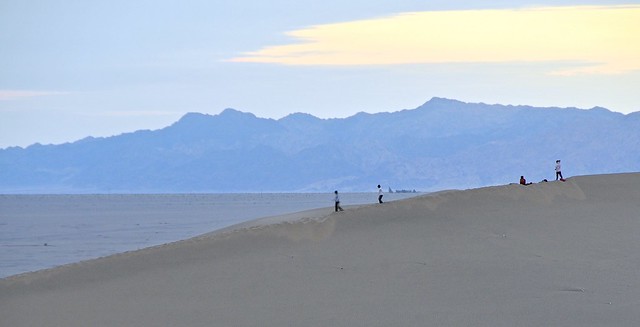 |
| The cloud cover made sunrise really unspectacular. |
 |
| But at least being there early meant there were few tourists and that I could go everywhere without interference from the guards. |
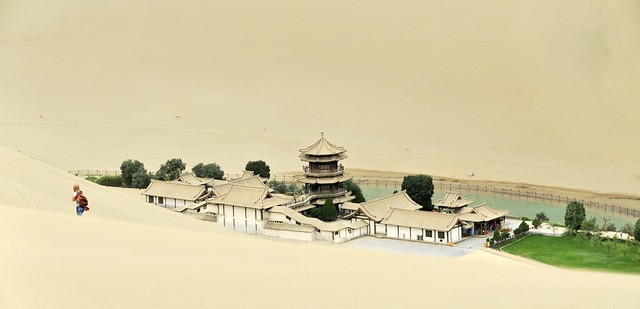 |
| A lone tourists makes her way up a dune |
 |
| Looking back towards the entrance. The entire temple complex is a modern reconstruction of dilapidated buildings that were torn down in the 1960s. |
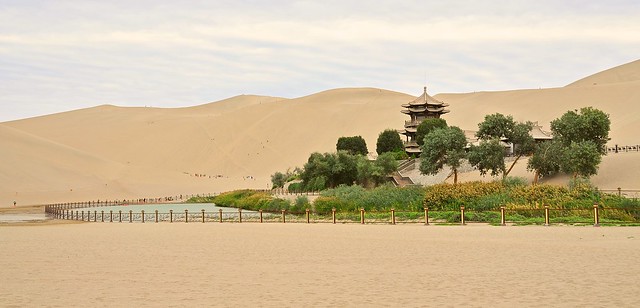 |
| Just before 8:00 and not many tourists by the lake. |
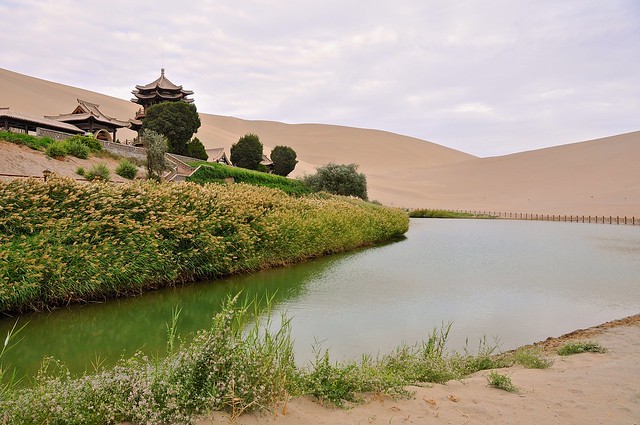 |
| In the 1960s the lake's average depth was 5 meters. By the mid-1990s, that had shrunk to about 0.9 m and split into two separate lakes. The city has been refilling the lake since then, restoring much of its size. |
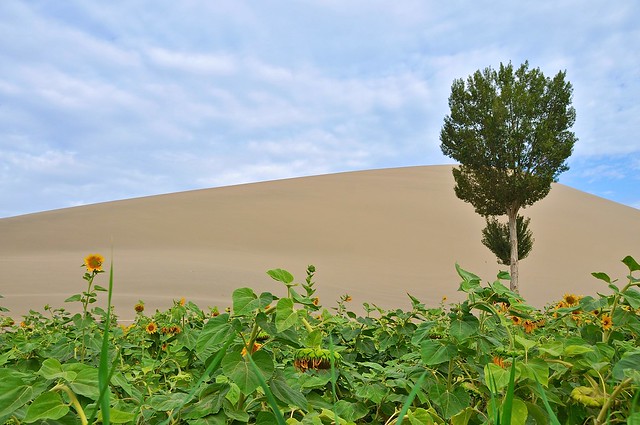 |
| Sunflowers and a lone tree contrast against the dunes. |
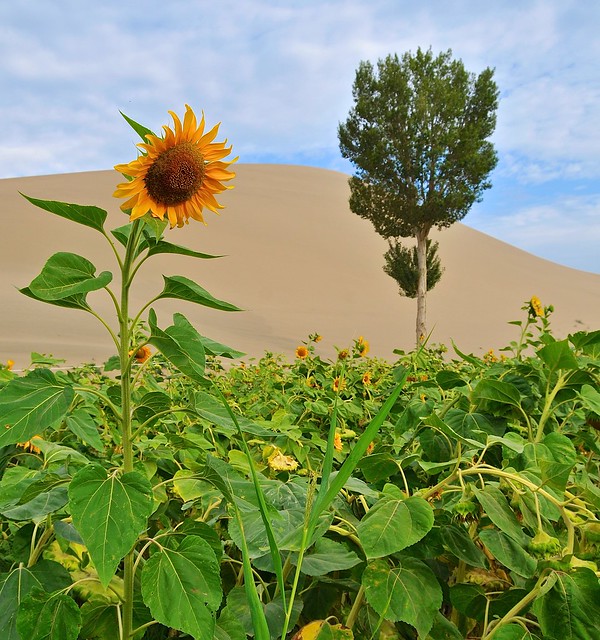 |
| A sunflower tends to his brethren. |
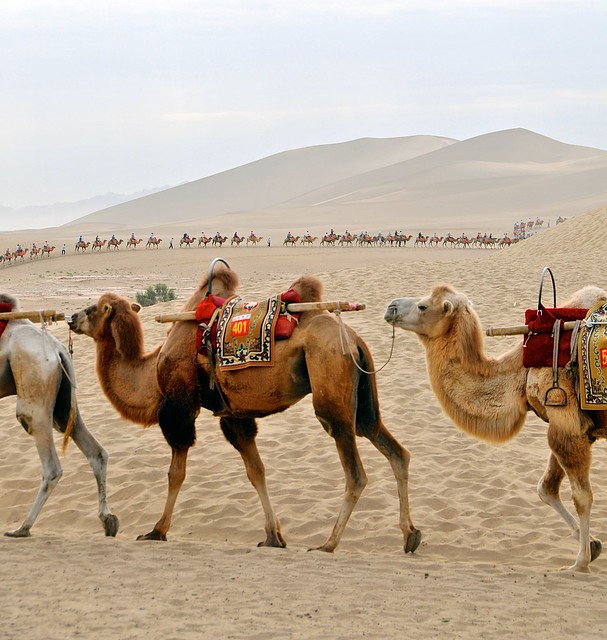 |
| Camels coming and going, with a healthy line of tourists at 9:00 |
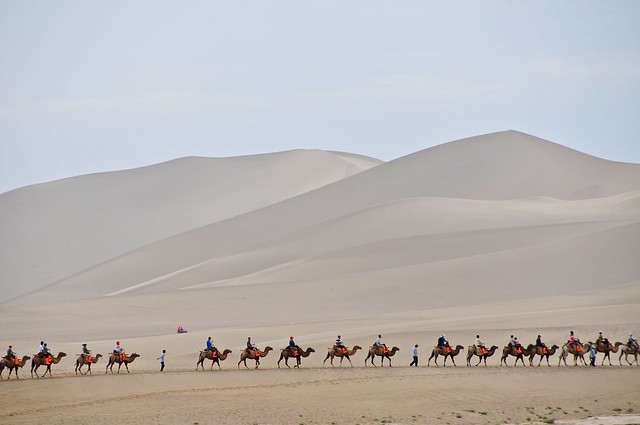 |
| Camel train for orange-booted tourists. |
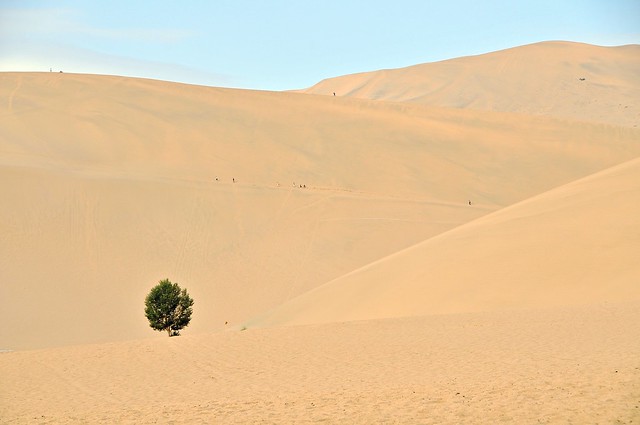 |
| A lonesome tree. |
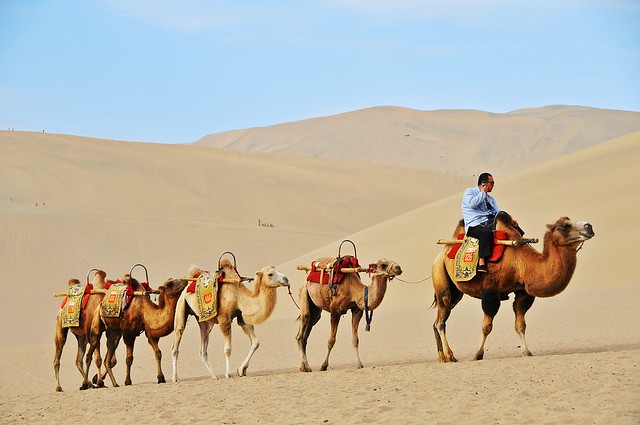 |
| Camel herder in dress shirt and tie, talking on his cell phone, returns camels to the tourist muster area. |
 |
| You can take a 3-minute trip over the dunes in an ultralight glider: takeoff, climb, circle, land. |
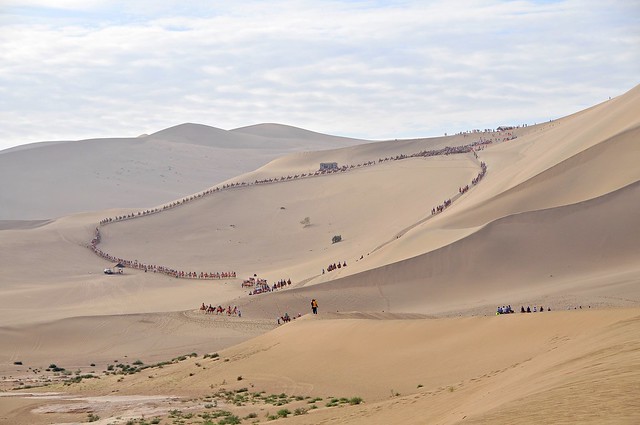 |
| The camel train doesn't look like much fun or very good value. |
 |
| A MIG-15 on display just inside the dune ticket office. |
As I left the dune complex through the official entrance/exit, I stopped to look at one of the statues/monuments they have outside the complex. Apparently I was too close to the monument for the tastes of a Chinese photographer, who loudly buzzed at me to get my attention and then made shooing gestures to indicate he wanted me out of his picture. This kind of brazen rudeness is entirely typical of Chinese tourists, not in small part because Chinese tourists tend to be quite wealthy (even by Western standards, I think). This Chinese tourist had a big, expensive full-frame DSLR—probably about a $4,000 camera, with lens—something which was entirely unsurprising to see on a Chinese tourist. Usually when I travel, I don't see many people who have a better camera than I do, as most people with DSLRs tend to have entry-level consumer cameras. In China, however, it seemed like most DSLR owners had the very latest and greatest cameras. If Chinese consumers can afford it, they can often afford the very best. And because China is a hyper-capitalist society where the accumulation of money is virtually the highest value of all, those who can afford such things often act in incredibly entitled ways.
Town & Market
After two nights of staying at the dunes, and getting my fill of them, I moved into town, settling on a Chinese hostel that doesn't caters to tourists (and may not have had a license to accept foreigners). It was a family run guesthouse in a courtyard apartment block just northeast of Charley Johng's city hostel, and it was pretty good. Although the dorm was in an attic with Chinese guys who smoked, the shared bathrooms were brand new and absolutely spotless. It was nice to see that some places or people shave strong hygienic standards.
You really only need two days to see everything in Dunhuang, but the
city is so relaxing and tranquil that I stayed for four nights here.
Dunhuang is definitely a tourist town, but it's a very charming one,
with spacious and relaxed streets, a lively night market, and a pace
that is much slower and an atmosphere much more welcoming than in most
Chinese cities
You start to see a more conservative Muslim culture in Dunhuang, with Hui women and girls dressed conservatively and wearing scarves even in the heat of summer. Many of the food stalls at the night market are operated by Muslims, while in the covered food market there are a bunch of Korean diners. It all combines into an open and welcoming atmosphere of greater diversity, even if it is still an overwhelmingly Han town.
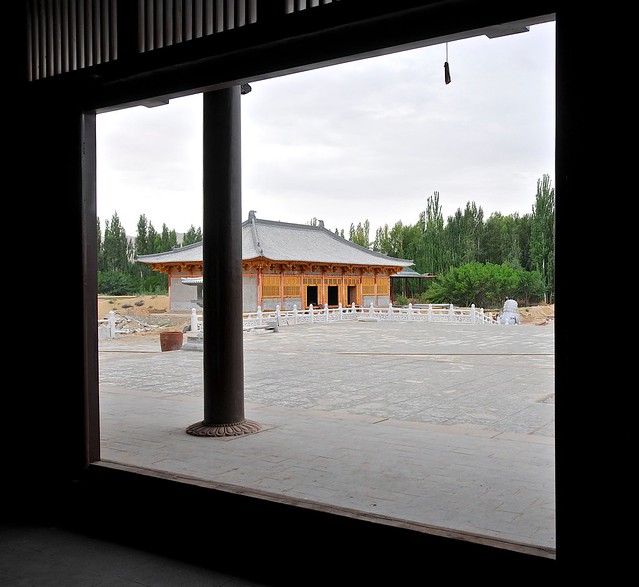 |
| A new temple was being built along the road to the sand dunes. |
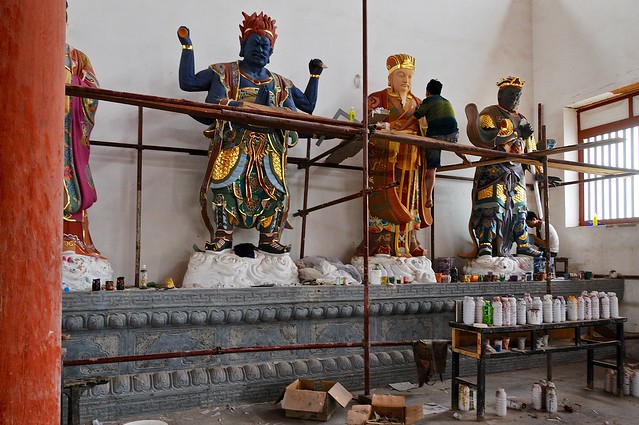 |
| New statues being painted. |
 |
| The Dunhuang Museum is, like most museums in China, really quite good. And free. |
 |
| Island parks accessible only by walking stones in the river. |
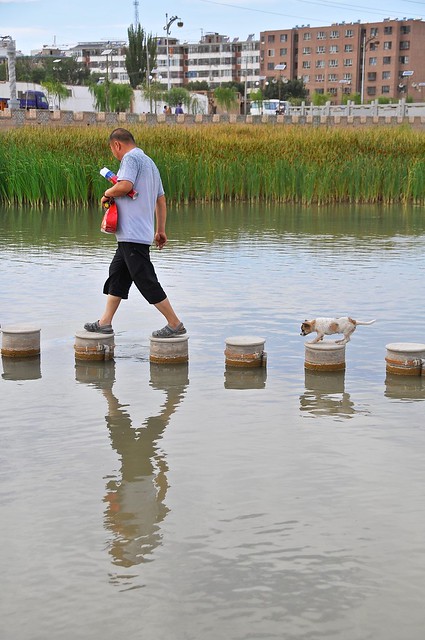 |
| Taking his dog to the park. |
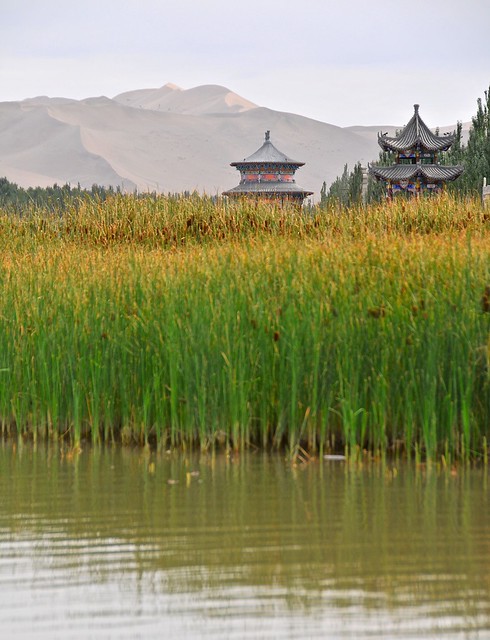 |
| Looking south from an island towards the dunes. |
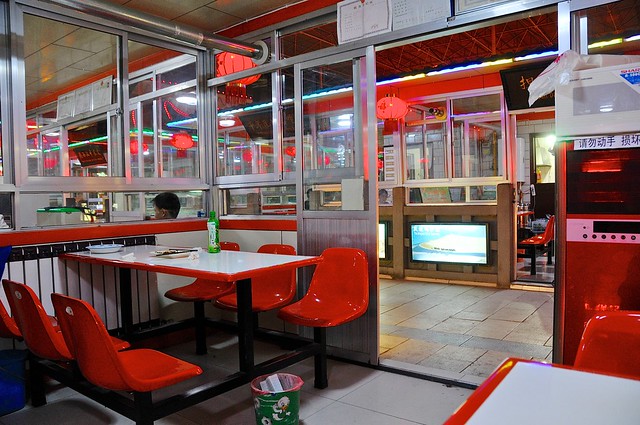 |
| Korean restaurants inside the covered market. |
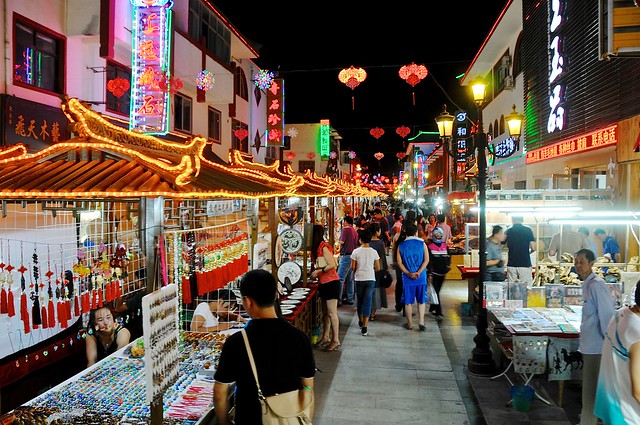 |
| The night market, with souvenir stalls. |
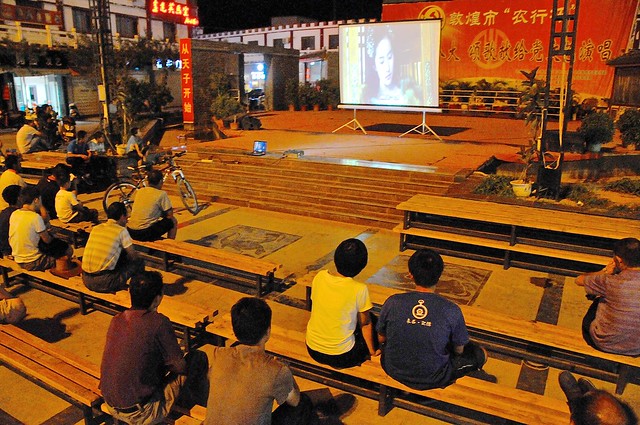 |
| Showing movies in the plaza. |
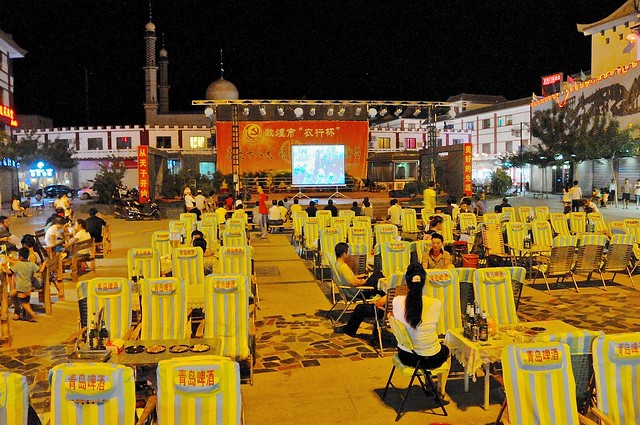 |
| With Chinese open-air restaurants nearby. |
There was this one food stall in the market that sold a variety of Hui kebabs. It was very popular, and there were two teenage Hui girls and a guy as cooks, with both girls wearing headscarves despite the heat of the fire. One of the girls was incredibly charismatic, joking with her coworkers and customers in a very exuberant way. I'm terrible at taking people pictures, and always feel intrusive or wrong when taking pictures int hat context—something exacerbated when shooting with a DSLR. Although she would have made a great picture, I didn't take one; it's in times like this that I think having an unobtrusive camera or a good phone camera would be great, especially since everyone everywhere take pictures with their phones.
 |
| In the covered market you can get the original Chinese hamburger, or roujiamo, made of chopped pork and chili peppers between flat bread. This kind of English text—complete with anti-litter massages—is highly atypical in China. |
Mogao
The
caves of Mogao are the other big reason to visit Dunhuang. Since Dunhuang was an oasis city that marked the end of the Taklamakan desert, silk road traders were grateful when they safely arrived to Dunhuang, and many of them showed their gratitude by contributing to the construction of almost 1,000 Buddhist caves at Mogao. Richly-decorated shrines and Buddhist scrolls were deposited in many of these caves, and although almost all of the scrolls were effectively looted by Western explorers and archaeologists in the early 20th Century, many wall paintings, murals, and statues survive. (Ironically, Western looting likely saved the scrolls from almost-certain destruction during the Cultural Revolution, though the Chinese like to gloss over that when they complain about Mogao artefacts being scattered through Western museums.)
You can get to Mogao by minibus from the town, for about 8 yuan. If you can find a place to rent a bicycle, however, I would strongly suggest renting one (and bringing lots of water), as this will let you get around on your own schedule and really soak up the atmosphere.
Only a handful of caves are available for viewing on any given day, with many people only being able to see about 7 or 8 caves. Combine that with a steep 150 yuan entrance fee, large numbers of tourists, as well as a very good museum that is free to enter, and I decided not to buy a ticket.
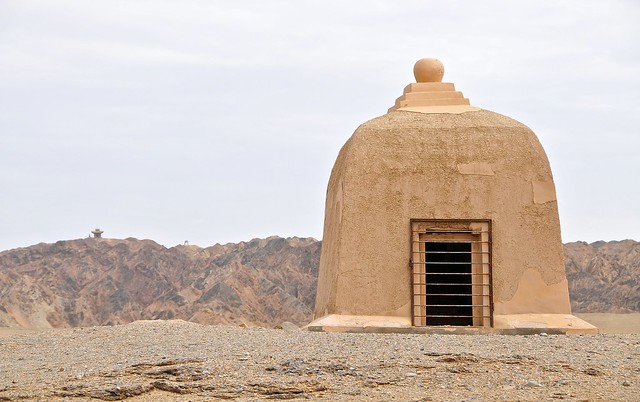 |
| A small stupa with a shrine inside. |
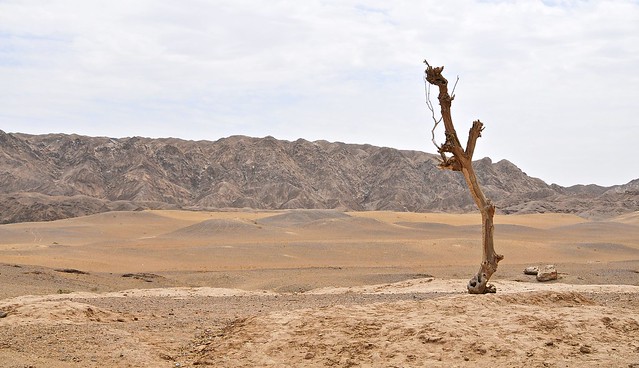 |
| For some reason this tree wasn't able to survive in this environment. |
 |
| View of the exterior of cave 96, the main temple, which contains a large Buddha. |
 |
| A mountaintop stupa in the distance. |
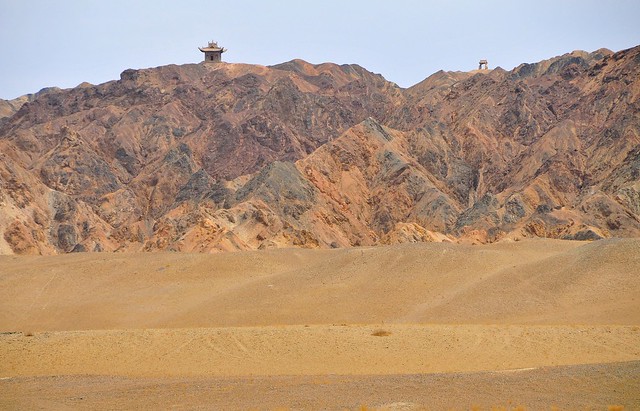 |
| The mountains east of Mogao hold a number of temples and gates. |
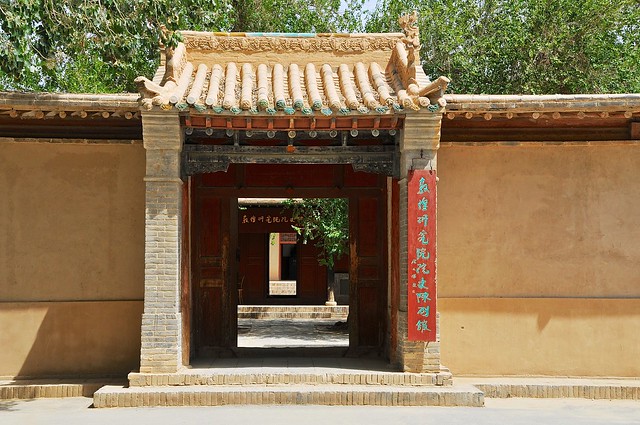 |
| Entrance way to one of the compounds around Mogao. |
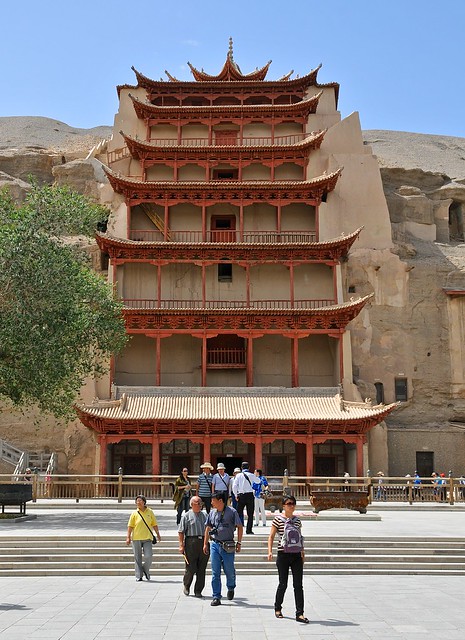 |
| Restored entrance to the main Mogao cave. You only need a ticket to go beyond the barrier. |
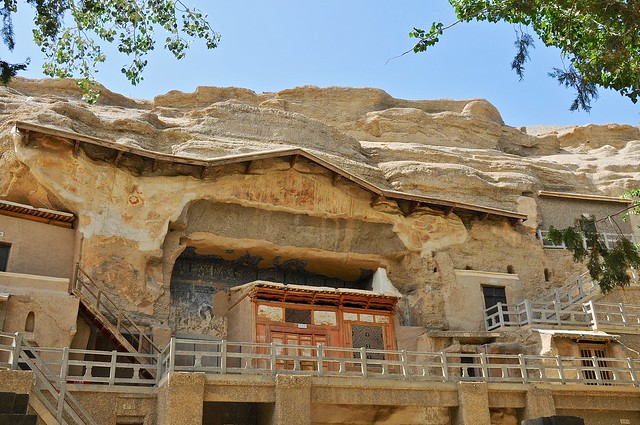 |
| View of one of the caves that is sometimes open. They rotate the caves on display to prevent excessive exposure. |
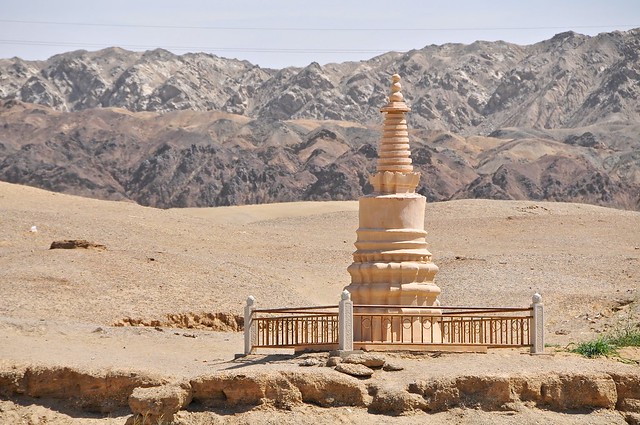 |
| Stupa just off the road. The design seems very similar to those frequently seen at Bagan, in Burma. |
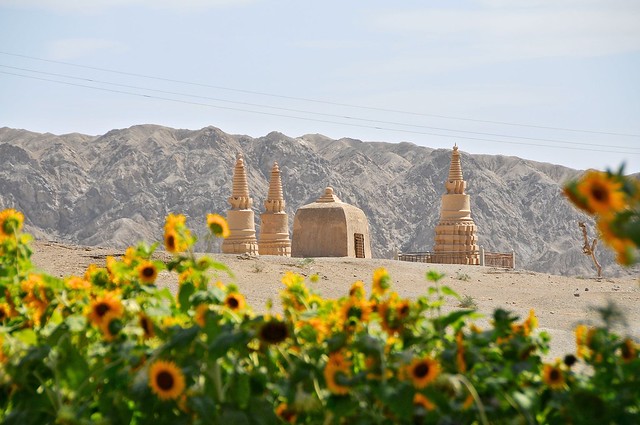 |
| A sunflower patch with some stupas in the background. |
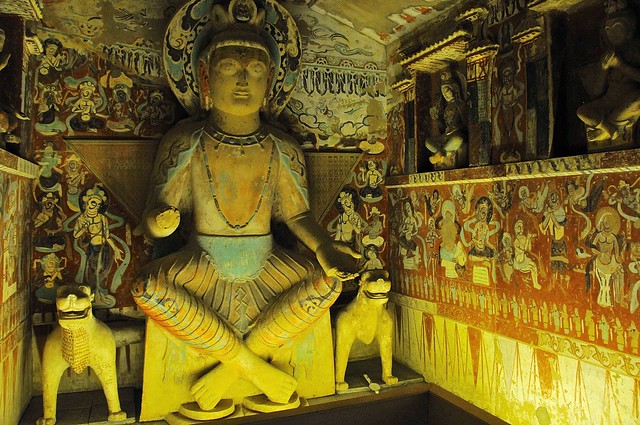 |
| The museum contains reproductions of a few of the caves |
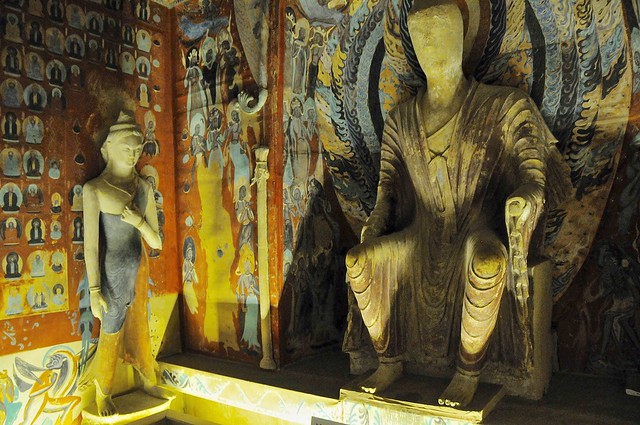 |
| Another of the cave mockups. Photography in the caves proper is banned. |
 |
| The entire valley is riddled with caves. |
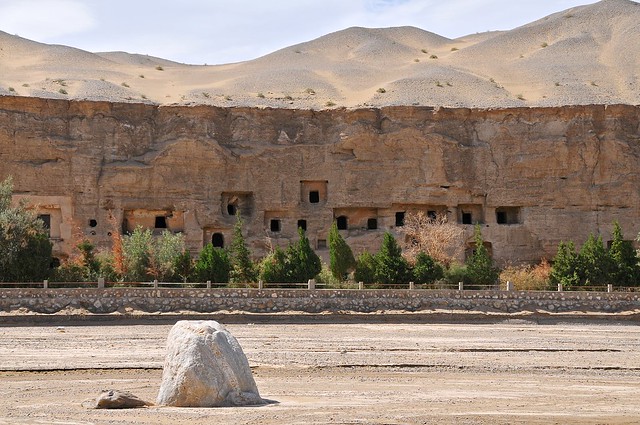 |
| Some large, some small, and most unrestored and open to the elements. |
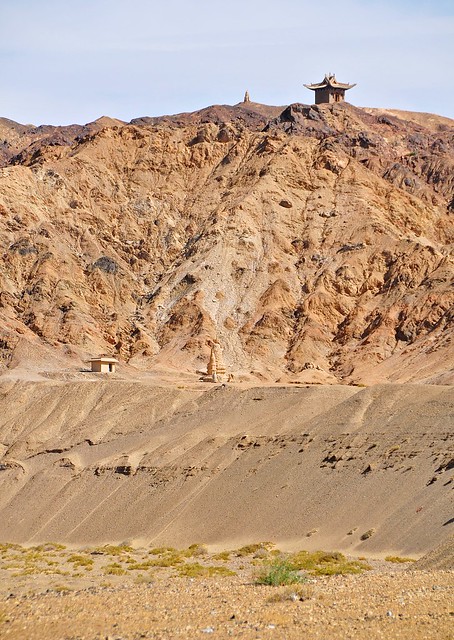 |
| After walking a bit in the valley I decided to climb up to that shrine. |
 |
| There was a path which made the ascent pretty easy. |
 |
| I made it to the top, where I was rewarded with the shrine and stupa. |
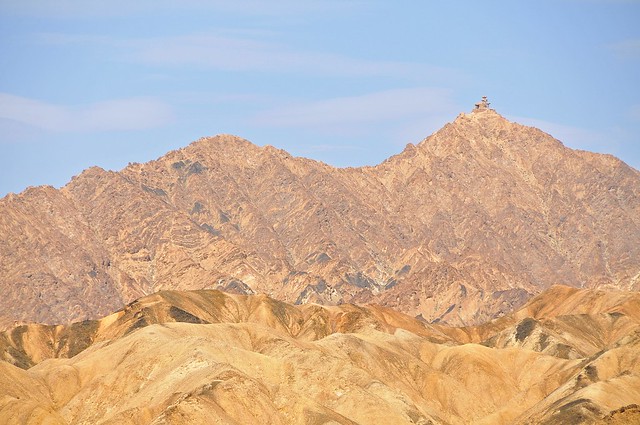 |
| Not going to make it there, however. |
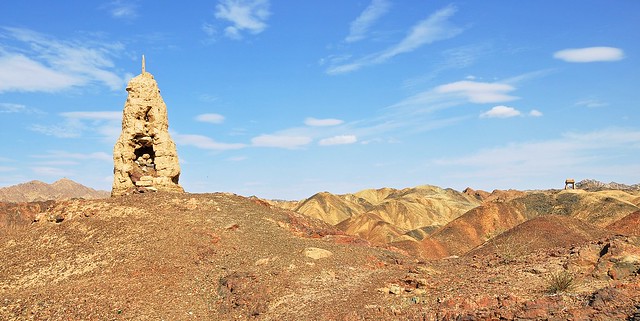 |
| An old and unrestored stupa, with a gate in the background. |
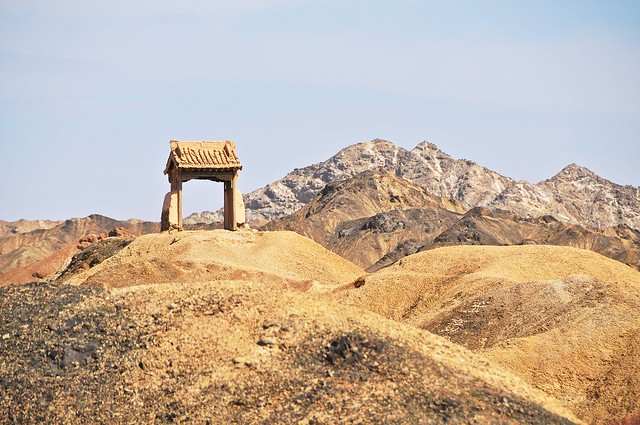 |
| Gate to nowhere. Or everywhere, I guess. |
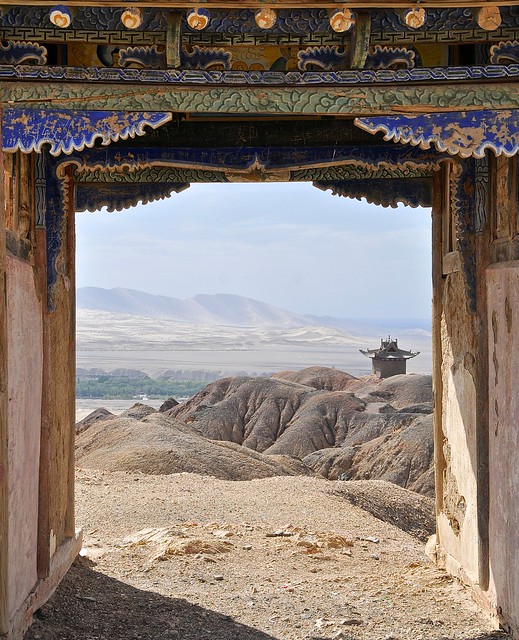 |
| But it does give great views of the Singing Dunes, however. |
 |
| The path from the shrine. |
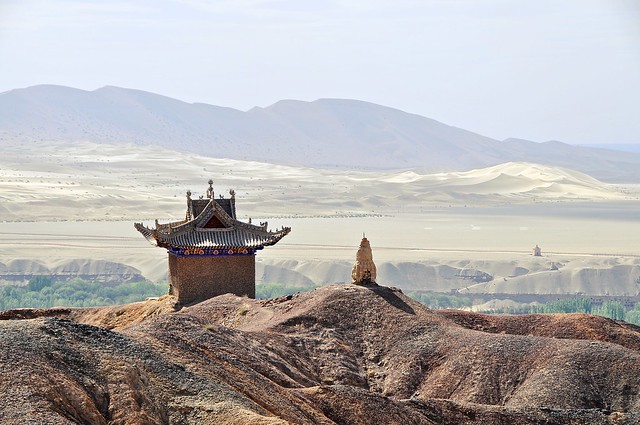 |
| Looking west towards the dunes. |
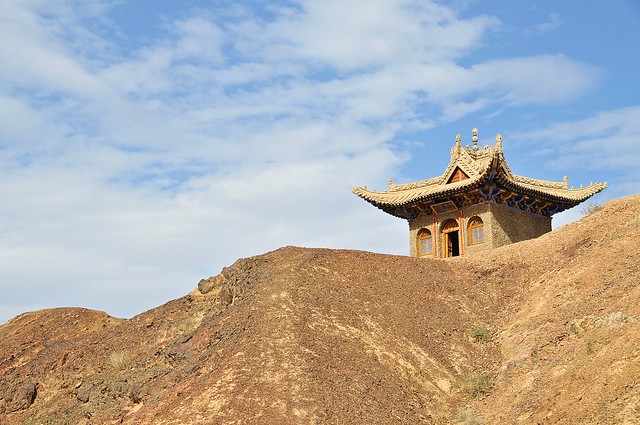 |
| The descent was much trickier, as I took another path that looked straightforward from the top but which was sketchy towards the bottom. |
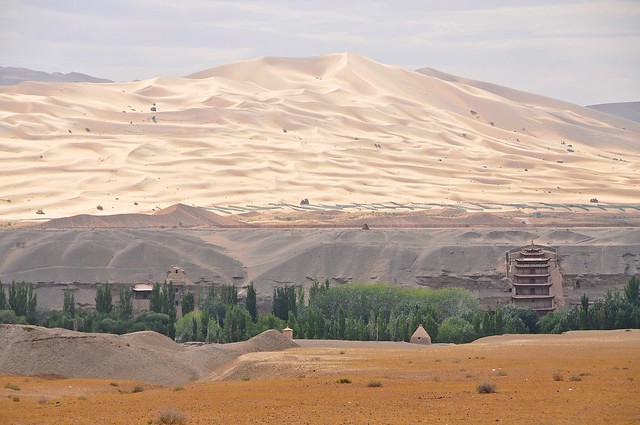 |
| The cave valley set against the Singing Dunes. |
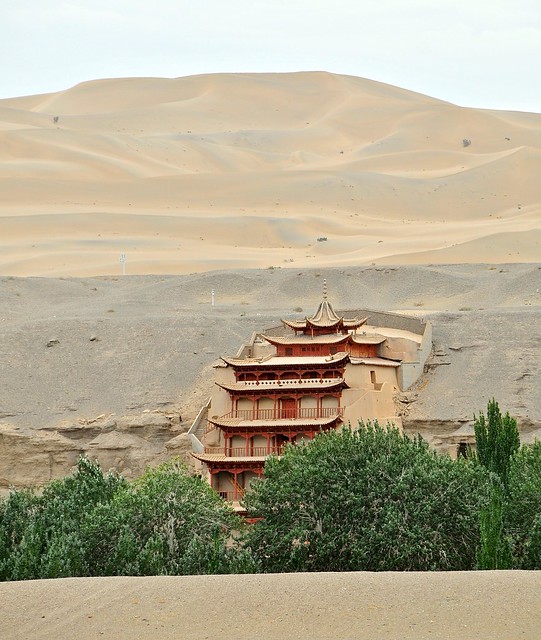 |
| I suppose it's only a matter of time before they have apartment buildings across from Mogao. Note the CCTV camera towers behind the temple. |
Night Bus to Turpan
Like so many other things, Lonely Planet's information on the Dunhuang bus station was out of date, as it had moved since the edition was researched. After finding the new station I bought a ticket on the night bus to Turpan, deciding to skip Hami. The price for the 800 km bus ride was 160 yuan—the same price as the Mogao ticket—and saved a night of accommodation.
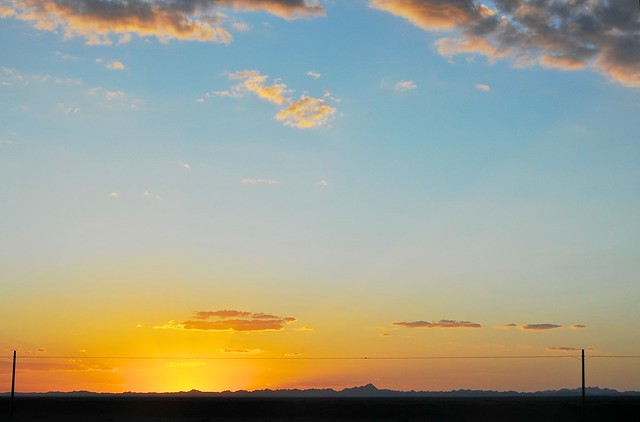 |
| View from the night bus. |
 |
| Luckily I had a window berth. |
Budget
August 14 in Dunhuang: 116 yuan
- Dune guesthouse: 40 yuan
- Bus from train station: 3 yuan
- Fruit: 21 yuan
- City bus x 2: 2 yuan
- North Korean noodles: 10 yuan
- Yoghurt, drinks, and dumplings: 28 yuan
- Hui kebabs: 12 yuan
August 15 in Dunhuang: 110 yuan
- Dune guesthouse: 40 yuan
- Drinks and snacks: 23 yuan
- Dinner: 25 yuan
- City bus x 2: 2 yuan
- Tissues & toiletries: 20 yuan
August 16 in Dunhuang: 125 yuan
- City guesthouse: 40 yuan
- Bus to & from Mogao: 16 yuan
- Fruit: 21 yuan
- City bus: 1 yuan
- Hamburger & snacks: 10 yuan
- Chopsticks, snacks & drinks: 40 yuan
- Korean hotpot & Coke: 15 yuan
August 17 in Dunhuang: 196 yuan
- Bus to Turpan: 160 yuan
- City bus: 1 yuan
- Yoghurt, soda, snacks: 15 yuan
- Hamburger and dinner: 20 yuan




























































































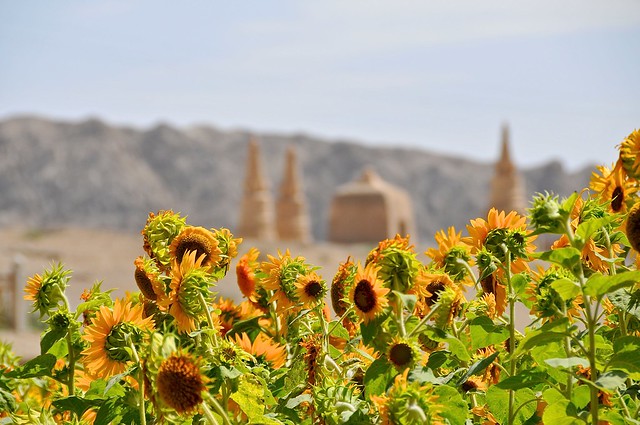
No comments:
Post a Comment